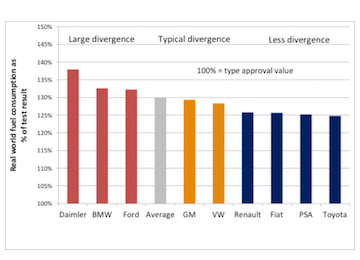
Carmakers pocketing millions through test cheating
The continued widespread manipulation of the way vehicles’ fuel consumption is tested is allowing carmakers to pocket millions of euro that should have been invested making cars more efficient , a new report has highlighted.
Interested in this kind of news?
Receive them directly in your inbox. Delivered once a week.
On average, the gap between real-world fuel consumption and carmakers’ claims has widened from 8% in 2001 to 31% in 2013 for private motorists, according to T&E’s latest Mind the Gap report. The gap for company car drivers now averages 43%. While carmakers are saving money, the cost is being passed on to motorists and the environment pays the price in higher carbon emissions.
The 2014 Mind the Gap report has analysed real-world fuel consumption by motorists and highlights the abuses by carmakers of the current tests and the failure of EU regulators to close loopholes.
The 2014 report found that, on the basis of Volkswagen’s recent claim that each gram of CO2 emissions it is required to cut costs it €100 million, the German manufacturer alone has saved around €1.7 billion by test manipulation. Extrapolated to the entire car industry the saving is at least €7 billion.
As a result, motorists are paying an average of around €2,800 for additional fuel that is being burned over the lifetime of the car. The cumulative cost of additional fuel consumed by newly manufactured cars is around €35 billion – five times more than has been saved by carmakers.
Mercedes, BMW and Ford head up the list of fuel economy cheaters in 2013 (see graph), with real-world emissions more than 35% above test results. In fact, since EU laws were adopted in 2008, half of the official fuel efficiency gains made have never actually been realised on the road. For Opel/Vauxhall cars, made by General Motors, less than 20% of the measured improvement in the past five years has actually been delivered on the road.
T&E says the obsolete official test is unrepresentative of modern cars and driving styles and contains loopholes that carmakers exploit. Carmakers produce specially prepared prototypes for the test and pay testing services that help to optimise the results. Modern engine management systems are even able to detect when a test is being carried out to deliver better fuel-efficiency results.
A new globally-recognised test is set to be introduced in 2017, but EU countries are putting off confirming the date under pressure from carmakers that want to be able to continue exploiting the current loopholes until at least 2022.
Greg Archer, T&E clean vehicles manager, said: ‘The gap between real-world fuel economy and distorted official test results has become a chasm. The current test has been utterly discredited by carmakers manipulating official test results. Unless Europe introduces the new global test in 2017 as planned, carmakers will continue to cheat laws designed to improve fuel efficiency and emissions reductions. The cost will be borne by drivers who will pay an additional €5,600 for fuel over the lifetime of the car compared to the official test result.’
The growing gap between test and real-world performance is also damaging EU growth and climate goals with cumulative additional fuel costs for motorists projected to reach nearly a trillion euros in 2030 and cumulative additional CO₂ emissions to amount to about 1.5 billion tonnes.
Recently US authorities identified carmakers as unfairly distorting tests and ordered Hyundai and Ford to reimburse customers for incorrect fuel economy figures. Mercedes and BMW-Mini are awaiting sanctions to be imposed.
‘The US has shown how to provide accurate consumer information and limit the abuse of official tests by carmakers through effective market surveillance by an independent regulator. In contrast, the EU system allows carmakers to pay testing authorities to test prototypes in their own laboratories using an obsolete test,’ Archer concluded.
Cars are responsible for 15% of Europe’s total CO2 emissions and are the single largest source of emissions in the transport sector. The EU’s first obligatory rules on carbon emissions require car manufacturers to limit their average car to a maximum of 130 grams of CO2 per km by 2015, and 95g by 2021.
